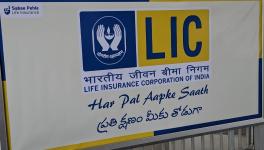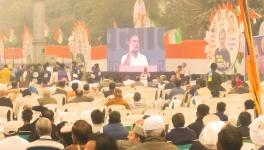TMC Beats Congress, Regional Parties With 96% of Income From Electoral Bonds
File Photo
Kolkata: West Bengal’s ruling Trinamool Congress (TMC) beat other regional parties and even the Congress in income earned from electoral bonds (EBs) in 2021-22. The TMC earned Rs 528.14 crore—96% of its total income—from EBs while the Congress got donations of only Rs 14 crore.
On November 3, TMC leaders Chandrima Bhattacharya and Arup Biswas signed the party’s audit report, which was subsequently available on the Election Commission of India’s (ECI) website.
According to the report, TMC’s total income in 2021-22 was around Rs 545.74 crore compared to Rs 42 crore in the previous fiscal—more than seven times that of the Congress’s approximately Rs 75.84. Interestingly, only four percent of the TMC’s income was from fees, subscriptions and collections from primary members.
An EB is a bearer instrument in the nature of a promissory note and an interest-free banking instrument available at State Bank of India (SBI) branches that can be purchased by an Indian citizen or a body incorporated in the country. Any individual/body can buy it and donate to political parties without revealing his/its identity.
The BJP introduced the Electoral Bond Scheme in 2017 through a finance Bill and the SBI started issuing them on April 1, 2018. As per the scheme, intended to fight the flow of black money, no party can receive funds or donations directly. Instead, every individual or company has to send his/their donations through EBs. Only the government knows who is donating to which party.
As the Association for Democratic reforms (ADR) notes: “Electoral bonds carry alphanumeric characters hidden in the top right corner of the bonds. It is visible only under ultraviolet light and invisible to the naked eye.”
In an affidavit, the government repeated its earlier claim that the alphanumeric characters are embedded for security reasons. However, several reports, including by The Quint, claimed that the feature was introduced to track donors. The government of the day can always access the donor’s details by demanding data from the SBI—only the public and the Opposition will be in the dark about the donor’s identity.
The ADR has alleged that the “arbitrary and unconstitutional” scheme has “patently endorsed and encouraged black money by permitting political parties into becoming a breeding ground for money”.
In January 2017, according to the ADR, there were a total of 1,500 political parties. As of September 30, 2020, the total number of political parties increased to 2,628. “The reason for this glut of new parties definitely points out the needle of suspicion towards the government’s controversial electoral bonds and unlimited and anonymous corporate donations.”
Arguing that a vast majority of these parties will never contest elections, the ADR said: “These parties may be involved in money laundering activities or may simply be using their status to turn black money into white.”
Ujjaini Halim, the state coordinator of West Bengal Election Watch, told Newsclick that “according to law, election funding must be transparent”.
“However, the scheme was passed in Parliament without any major discussions. Political parties are not liable to let the public know of electoral funding. There is lack of transparency in the whole process. Whenever a political party receives a large donation, there is a reason—even if not, there should be transparency in the whole process,” she said.
Contending that the common man has got “every right to know about it and the scheme crosses the path with the right to information,” Halim said, “Neither it comes under the purview of the right to information nor the ECI was earlier made privy to such information. It was only later decided that the Commission would be made privy to such information in a sealed envelope vide an interim Supreme Court order. Still, such information is not in the public domain.”
On the other hand, she said, the “government has taken steps like making cheques mandatory for donations of more than Rs 20,000. If so much transparency is demanded in such cases, then the nature of electoral bonds is contradictory”.
The system of EBs is “harmful for the democratic process of electoral democracy and its health”, she added. “It can be source of money laundering as the entire scheme is opaque. Even the question whether money laundering is happening through it cannot be proved as the whole thing is under wraps.”
According to the Central Information Commission, Halim said, “political parties are deemed as public authorities though they refuse to accept the same. The funding of public authorities should also be clear and transparent”.
CPI(M) leader Fuad Halim feels that parties like the BJP and TMC are now more “dependent on corporate funding”.
“Annual returns of most national parties reveal that out of the total Rs 16,000 crore collected by various national parties in the last three years, about Rs 12,000 crore was through electoral bonds—almost 75% of funding is through EBs,” Halim told Newsclick.
He claimed that corporate entities or high net worth individuals are purchasing EBs of more than Rs 1 crore to “influence” decision-making. “The TMC collected more than Rs 500 crore via EBs. This indicates that policy-making at the state level is slowly going to be dictated by donators who purchase these high-valued EBs.”
On the other hand, “several parties, including the CPI(M), which earlier refused to take money through corporate trusts and now through EBs, have approached the Supreme Court regarding the scheme’s opacity”, he added.
“Citizens should be told about who is supporting which political party—but neither corporate entities reveal to whom they are donating nor political parties disclose their source of donations. The opacity questions the right of West Bengal’s people to know about the source of TMC’s income,” Halim further added.
In the 2021 election year, the TMC’s income was around Rs 74.41 lakh, including Rs 42 crore from EBs. The audit reports of five national parties, except the BJP, on the ECI’s website show the TMC topping among Congress, CPI(M), BSP and National People’s Party.
CPI(M), the only party which is against EBs due to the scheme’s lack of transparency, earned 29% of income from levy of its party members and 40 % from voluntary donation.
According to a November ADR report, the BJP topped the chart of income through EBs with around Rs 4,238 crore (65%) out of the total donations worth Rs 6,500 crore received by 19 parties between 2017-18 and 2020-21.
As per data shared by the SBI in response to an ADR RTI application, EBs worth approximately Rs 2,673 crore were redeemed by parties in 2021-22.
Get the latest reports & analysis with people's perspective on Protests, movements & deep analytical videos, discussions of the current affairs in your Telegram app. Subscribe to NewsClick's Telegram channel & get Real-Time updates on stories, as they get published on our website.
























